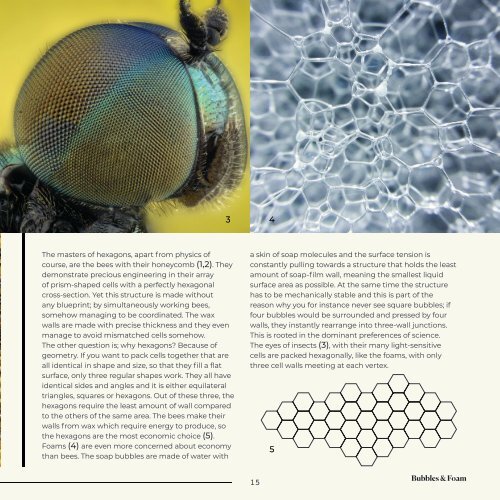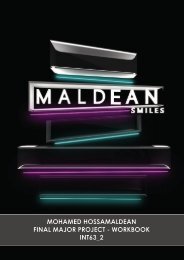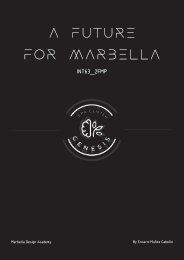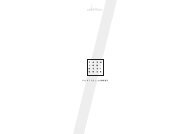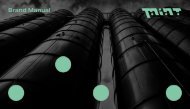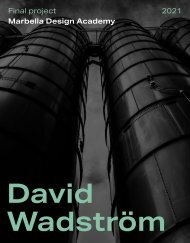Patterns in Nature, editorial design project by our 2nd-year student Ellen Andersin.
“Patterns In Nature”. A glimpse into the world of phenomenal natural patterns Editorial design project by our 2nd-year student Ellen Andersin. Marbella Design Academy - Spain – Founded 1995 - Tuition in English
“Patterns In Nature”.
A glimpse into the world of phenomenal natural patterns
Editorial design project by our 2nd-year student Ellen Andersin.
Marbella Design Academy - Spain – Founded 1995 - Tuition in English
Create successful ePaper yourself
Turn your PDF publications into a flip-book with our unique Google optimized e-Paper software.
3 4<br />
The masters of hexagons, apart from physics of<br />
c<strong>our</strong>se, are the bees with their honeycomb (1,2). They<br />
demonstrate precious eng<strong>in</strong>eer<strong>in</strong>g <strong>in</strong> their array<br />
of prism-shaped cells with a perfectly hexagonal<br />
cross-section. Yet this structure is made without<br />
any bluepr<strong>in</strong>t; <strong>by</strong> simultaneously work<strong>in</strong>g bees,<br />
somehow manag<strong>in</strong>g to be coord<strong>in</strong>ated. The wax<br />
walls are made with precise thickness and they even<br />
manage to avoid mismatched cells somehow.<br />
The other question is; why hexagons? Because of<br />
geometry. If you want to pack cells together that are<br />
all identical <strong>in</strong> shape and size, so that they fill a flat<br />
surface, only three regular shapes work. They all have<br />
identical sides and angles and it is either equilateral<br />
triangles, squares or hexagons. Out of these three, the<br />
hexagons require the least amount of wall compared<br />
to the others of the same area. The bees make their<br />
walls from wax which require energy to produce, so<br />
the hexagons are the most economic choice (5).<br />
Foams (4) are even more concerned about economy<br />
than bees. The soap bubbles are made of water with<br />
a sk<strong>in</strong> of soap molecules and the surface tension is<br />
constantly pull<strong>in</strong>g towards a structure that holds the least<br />
amount of soap-film wall, mean<strong>in</strong>g the smallest liquid<br />
surface area as possible. At the same time the structure<br />
has to be mechanically stable and this is part of the<br />
reason why you for <strong>in</strong>stance never see square bubbles; if<br />
f<strong>our</strong> bubbles would be surrounded and pressed <strong>by</strong> f<strong>our</strong><br />
walls, they <strong>in</strong>stantly rearrange <strong>in</strong>to three-wall junctions.<br />
This is rooted <strong>in</strong> the dom<strong>in</strong>ant preferences of science.<br />
The eyes of <strong>in</strong>sects (3), with their many light-sensitive<br />
cells are packed hexagonally, like the foams, with only<br />
three cell walls meet<strong>in</strong>g at each vertex.<br />
5<br />
15<br />
Bubbles & Foam


